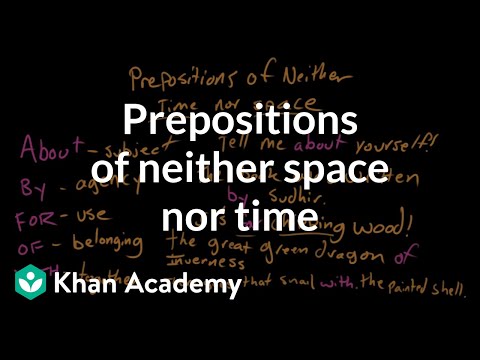26.5: Prepositions
- Page ID
- 257069
\( \newcommand{\vecs}[1]{\overset { \scriptstyle \rightharpoonup} {\mathbf{#1}} } \)
\( \newcommand{\vecd}[1]{\overset{-\!-\!\rightharpoonup}{\vphantom{a}\smash {#1}}} \)
\( \newcommand{\dsum}{\displaystyle\sum\limits} \)
\( \newcommand{\dint}{\displaystyle\int\limits} \)
\( \newcommand{\dlim}{\displaystyle\lim\limits} \)
\( \newcommand{\id}{\mathrm{id}}\) \( \newcommand{\Span}{\mathrm{span}}\)
( \newcommand{\kernel}{\mathrm{null}\,}\) \( \newcommand{\range}{\mathrm{range}\,}\)
\( \newcommand{\RealPart}{\mathrm{Re}}\) \( \newcommand{\ImaginaryPart}{\mathrm{Im}}\)
\( \newcommand{\Argument}{\mathrm{Arg}}\) \( \newcommand{\norm}[1]{\| #1 \|}\)
\( \newcommand{\inner}[2]{\langle #1, #2 \rangle}\)
\( \newcommand{\Span}{\mathrm{span}}\)
\( \newcommand{\id}{\mathrm{id}}\)
\( \newcommand{\Span}{\mathrm{span}}\)
\( \newcommand{\kernel}{\mathrm{null}\,}\)
\( \newcommand{\range}{\mathrm{range}\,}\)
\( \newcommand{\RealPart}{\mathrm{Re}}\)
\( \newcommand{\ImaginaryPart}{\mathrm{Im}}\)
\( \newcommand{\Argument}{\mathrm{Arg}}\)
\( \newcommand{\norm}[1]{\| #1 \|}\)
\( \newcommand{\inner}[2]{\langle #1, #2 \rangle}\)
\( \newcommand{\Span}{\mathrm{span}}\) \( \newcommand{\AA}{\unicode[.8,0]{x212B}}\)
\( \newcommand{\vectorA}[1]{\vec{#1}} % arrow\)
\( \newcommand{\vectorAt}[1]{\vec{\text{#1}}} % arrow\)
\( \newcommand{\vectorB}[1]{\overset { \scriptstyle \rightharpoonup} {\mathbf{#1}} } \)
\( \newcommand{\vectorC}[1]{\textbf{#1}} \)
\( \newcommand{\vectorD}[1]{\overrightarrow{#1}} \)
\( \newcommand{\vectorDt}[1]{\overrightarrow{\text{#1}}} \)
\( \newcommand{\vectE}[1]{\overset{-\!-\!\rightharpoonup}{\vphantom{a}\smash{\mathbf {#1}}}} \)
\( \newcommand{\vecs}[1]{\overset { \scriptstyle \rightharpoonup} {\mathbf{#1}} } \)
\( \newcommand{\vecd}[1]{\overset{-\!-\!\rightharpoonup}{\vphantom{a}\smash {#1}}} \)
\(\newcommand{\avec}{\mathbf a}\) \(\newcommand{\bvec}{\mathbf b}\) \(\newcommand{\cvec}{\mathbf c}\) \(\newcommand{\dvec}{\mathbf d}\) \(\newcommand{\dtil}{\widetilde{\mathbf d}}\) \(\newcommand{\evec}{\mathbf e}\) \(\newcommand{\fvec}{\mathbf f}\) \(\newcommand{\nvec}{\mathbf n}\) \(\newcommand{\pvec}{\mathbf p}\) \(\newcommand{\qvec}{\mathbf q}\) \(\newcommand{\svec}{\mathbf s}\) \(\newcommand{\tvec}{\mathbf t}\) \(\newcommand{\uvec}{\mathbf u}\) \(\newcommand{\vvec}{\mathbf v}\) \(\newcommand{\wvec}{\mathbf w}\) \(\newcommand{\xvec}{\mathbf x}\) \(\newcommand{\yvec}{\mathbf y}\) \(\newcommand{\zvec}{\mathbf z}\) \(\newcommand{\rvec}{\mathbf r}\) \(\newcommand{\mvec}{\mathbf m}\) \(\newcommand{\zerovec}{\mathbf 0}\) \(\newcommand{\onevec}{\mathbf 1}\) \(\newcommand{\real}{\mathbb R}\) \(\newcommand{\twovec}[2]{\left[\begin{array}{r}#1 \\ #2 \end{array}\right]}\) \(\newcommand{\ctwovec}[2]{\left[\begin{array}{c}#1 \\ #2 \end{array}\right]}\) \(\newcommand{\threevec}[3]{\left[\begin{array}{r}#1 \\ #2 \\ #3 \end{array}\right]}\) \(\newcommand{\cthreevec}[3]{\left[\begin{array}{c}#1 \\ #2 \\ #3 \end{array}\right]}\) \(\newcommand{\fourvec}[4]{\left[\begin{array}{r}#1 \\ #2 \\ #3 \\ #4 \end{array}\right]}\) \(\newcommand{\cfourvec}[4]{\left[\begin{array}{c}#1 \\ #2 \\ #3 \\ #4 \end{array}\right]}\) \(\newcommand{\fivevec}[5]{\left[\begin{array}{r}#1 \\ #2 \\ #3 \\ #4 \\ #5 \\ \end{array}\right]}\) \(\newcommand{\cfivevec}[5]{\left[\begin{array}{c}#1 \\ #2 \\ #3 \\ #4 \\ #5 \\ \end{array}\right]}\) \(\newcommand{\mattwo}[4]{\left[\begin{array}{rr}#1 \amp #2 \\ #3 \amp #4 \\ \end{array}\right]}\) \(\newcommand{\laspan}[1]{\text{Span}\{#1\}}\) \(\newcommand{\bcal}{\cal B}\) \(\newcommand{\ccal}{\cal C}\) \(\newcommand{\scal}{\cal S}\) \(\newcommand{\wcal}{\cal W}\) \(\newcommand{\ecal}{\cal E}\) \(\newcommand{\coords}[2]{\left\{#1\right\}_{#2}}\) \(\newcommand{\gray}[1]{\color{gray}{#1}}\) \(\newcommand{\lgray}[1]{\color{lightgray}{#1}}\) \(\newcommand{\rank}{\operatorname{rank}}\) \(\newcommand{\row}{\text{Row}}\) \(\newcommand{\col}{\text{Col}}\) \(\renewcommand{\row}{\text{Row}}\) \(\newcommand{\nul}{\text{Nul}}\) \(\newcommand{\var}{\text{Var}}\) \(\newcommand{\corr}{\text{corr}}\) \(\newcommand{\len}[1]{\left|#1\right|}\) \(\newcommand{\bbar}{\overline{\bvec}}\) \(\newcommand{\bhat}{\widehat{\bvec}}\) \(\newcommand{\bperp}{\bvec^\perp}\) \(\newcommand{\xhat}{\widehat{\xvec}}\) \(\newcommand{\vhat}{\widehat{\vvec}}\) \(\newcommand{\uhat}{\widehat{\uvec}}\) \(\newcommand{\what}{\widehat{\wvec}}\) \(\newcommand{\Sighat}{\widehat{\Sigma}}\) \(\newcommand{\lt}{<}\) \(\newcommand{\gt}{>}\) \(\newcommand{\amp}{&}\) \(\definecolor{fillinmathshade}{gray}{0.9}\) Prepositions are relation words; they can indicate location, time, or other more abstract relationships. A preposition combines with another word (usually a noun or pronoun) called the complement. Prepositions are still in bold, and their complements are in italics:
Prepositions are relation words; they can indicate location, time, or other more abstract relationships. A preposition combines with another word (usually a noun or pronoun) called the complement. Prepositions are still in bold, and their complements are in italics:
- The woods behind my house are super creepy atnight.
- She sang untilthree in the morning.
- They were happy forhim.
- He counted tothree.
Prepositions generally come before their complements (e.g., in England, under the table, of Elena). However, there are a small handful of exceptions, including notwithstanding and ago:
- Financial limitationsnotwithstanding, Phil paid back his debts.
- He was released three daysago.
Prepositions of location are pretty easily defined (near, far, over, under, etc.), and prepositions about time are as well (before, after, at, during, etc.). Prepositions of “more abstract relationships,” however, are a little more nebulous in their definition. The video below gives a good overview of this category of prepositions:
Note: The video said that prepositions are a closed group, but it never actually explained what a closed group is. A closed group simply refers to a part of speech that doesn’t allow in new words. While it’s easy to invent new nouns (e.g., selfie, Google), you can’t invent new words in a closed group.
So far, all of the prepositions we’ve looked at have been one word (and most of them have been one syllable). The most common prepositions are one-syllable words. According to one ranking, the most common English prepositions are on, in, to, by, for, with, at, of, from, as.
There are also some prepositions that have more than one word:
- in spite of (She made it to work in spite of the terrible traffic.)
- by means of (He traveled by means of boat.)
- except for (Joan invited everyone to her party except for Ben.)
- next to (Go ahead and sit down next to Jean-Claude.)
Practice
Identify the prepositions in the following sentences:
- I love every painting by Vermeer except for The Girl with the Pearl Earring.
- In spite of their fight, Beatriz wanted to know if she would still see Alexandre before lunch.
- He only talks about two things: his band and his dogs.
[reveal-answer q=”478512″]Show Answer[/reveal-answer]
[hidden-answer a=”478512″]
The prepositions have been bolded in the sentences below:
- I love every painting by Vermeer except forThe Girl with the Pearl Earring.
- In spite of their fight, Beatriz wanted to know if she would still see Alexandre before lunch.
- He only talks about two things: his band and his dogs.
[/hidden-answer]
Using Prepositions
A lot of struggles with prepositions come from trying to use the correct preposition. Some verbs require specific prepositions. Here’s a table of some of the most commonly misused preposition/verb pairs:
| different from | comply with | dependent on | think of or about |
| need of | profit by | glad of | bestow upon |
Some verbs take a different preposition, depending on the object of the sentence:
| agree with a person | agree to a proposition | part from (a person) | part with (a thing) |
| differ from (person or thing) | differ from or with an opinion | confide in (to trust in) | confide to (to intrust to) |
| reconcile with (a person) | reconcile to (a statement or idea) | confer on (to give) | confer with (to talk with) |
| compare with (to determine value) | compare to (because of similarity) | convenient to (a place) | convenient for (a purpose) |
When multiple objects take the same preposition, you don’t need to repeat the preposition. For example, in the sentence “I’ll read any book by J.K. Rowling or R. L. Stine,” both J. K. Rowling and R. L. Stine are objects of the preposition by, so it only needs to appear once in the sentence. However, you can’t do this when you have different prepositions. Let’s look at this using a common phrase: “We fell out of the frying pan and into the fire.” If you leave out one of the prepositions, as in “We fell out of the frying pan and the fire,” the sentence is saying that we fell out of the frying pan and out of the fire, which would be preferable, but isn’t the case in this idiom.
Prepositions in Sentences
You’ll often hear about prepositional phrases. A prepositional phrase includes a preposition and its complement (e.g., “behindthe house” or “along time ago“). These phrases can appear at the beginning or end of sentences. When they appear at the beginning of a sentence, they typically need a comma afterwards:
- You can drop that off behind the house.
- A long time ago, dinosaurs roamed the earth.
- As the saying goes, hard work always pays off.
Ending a Sentence with a Preposition
It is 100 percent okay to end a sentence with a preposition. The rule against doing so stems from Latin, which belongs to a completely different language family than English. Using a terminal preposition can often make your writing smoother and more concise. Winston Churchill is credited with saying “This is the sort of English up with which I will not put,” when he was criticized for his use of terminal prepositions. (A more natural way to phrase Churchill’s glib quote would be “This is the sort of English I will not put up with.”)
However, it’s still best to avoid using terminal prepositions unnecessarily. If your sentence ends with a preposition and would still mean the same thing without the preposition, take it out. For example:
- Where are you at?
- That’s not what it’s used for.
If you remove at, the sentence becomes “Where are you?” This means the same thing, so removing at is a good idea. However, if you remove for, the sentence becomes “That’s not what it’s used,” which doesn’t make sense.
Practice
Read each sentence and determine if the prepositions are being used correctly. If they are not, re-write the sentence.
- Do you have any idea why Olivia keeps calling for?
- You have no idea how much trouble you’re in.
- Luiz agreed with hand his credit card over to the cashier.
- Last week Ngozi reconciled to the new prices and her new co-worker.
[practice-area rows=”4″][/practice-area]
[reveal-answer q=”196326″]Show Answer[/reveal-answer]
[hidden-answer a=”196326″]
- Incorrect. The preposition for does not work with the preposition why. There are two potential revisions for this sentence:
- Do you have any idea why Olivia keeps calling?
- Do you have any idea what Olivia keeps calling for?
- Correct. The preposition in at the end of the sentence is necessary. “You have no idea how much trouble you are” means something different than the sentence’s original intent.
- Incorrect. The preposition is with. You agree with a person, but you agree to do something:
- Luiz agreed to hand his credit card over to the cashier.
- Luiz agreed with the cashier.
- Incorrect. There’s a missing preposition in the sentence. It should read: “Last week Ngozi reconciled to the new prices and with her new co-worker.” You reconcile to a fact and with a person.
[/hidden-answer]
- Revision and Adaptation. Provided by: Lumen Learning. License: CC BY-SA: Attribution-ShareAlike
- Preposition and postposition. Provided by: Wikipedia. Located at: https://en.wikipedia.org/wiki/Preposition_and_postposition. License: CC BY-SA: Attribution-ShareAlike
- Prepositions of neither space nor time. Authored by: David Rheinstrom. Provided by: Khan Academy. Located at: https://www.khanacademy.org/humanities/grammar/partsofspeech/the-preposition/v/prepositions-of-neither-space-nor-time. License: CC BY-NC-SA: Attribution-NonCommercial-ShareAlike
- Image of box. Authored by: Lek Potharam. Provided by: The Noun Project. Located at: https://thenounproject.com/search/?q=put&i=17426. License: CC BY: Attribution
- Practical Grammar and Composition. Authored by: Thomas Wood. Located at: http://www.gutenberg.org/ebooks/22577. Project: Project Gutenberg. License: Public Domain: No Known Copyright


